
Welcome to the webpage of Pňovany – Konstantinovy Lázně – Bezdružice local railway
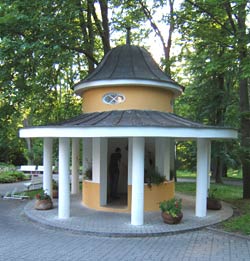
The picturesque spa town of Konstantinovy Lázně (Konstantinsbad) lies in the western part of the Czech Republic, in the middle of the area delimited by Karlovy Vary (Carlsbad) and Mariánské Lázně (Marienbad) spas and the city of Pilsen (Pilsner Urquell brewery). Konstantinsbad is the centre of a quiet submontane area, full of beautiful natural secluded places, healing mineral springs, and ruins of medieval castles. The best known castle is Švamberk (Schwamberg), the ruins of which on top of the Krasíkov table mountain are the symbol of the region, whereas Gutštejn over the Hadovka brook is considered to be the most romantic remains of a castle in the Czech Republic. The medieval monastery of Teplá and the town of Úterý are fascinating by their history and architecture.
The whole region is a paradise for cyclist, lovers of history, hikers and spa guests who appreciate its peace and clean air. The local railway Pňovany – Konstantinovy Lázně – Bezdružice leading to the land of quiet below the Krasíkov castle has been in operation since 1901.
History of the Local Railway
Inhabitants of the region around the town of Bezdružice wished to have railway connection as early as in 1872 when the main line from Vienna through Pilsen and Marienbad to Cheb (Eger) was being constructed. However, the mail line missed their area in the end. The plans for the construction of a local railway from Pňovany-u-Plzně (formerly Nový Dvůr) – a station on the main line – through Trpísty, Cebiv and Konstantinsbad to Bezdružice were drawn up only in 1894. The construction began in 1899, and the opening ceremony took place on 2 June 1901 while regular operation of three pairs of trains a day began four days later.
The line is 24 km long, the steepest ascent is as high as 26 per mil, and the minimum curve radius is 200 meters. The original maximum train speed was 30 km/h; today it is 60 km/h. The biggest structure on the track is a steel bridge with stone pillars across the valley of the Mže river, 210 m long and almost 50 m high. The depot for the railway was constructed at Bezdružice, two small engines series 97 were supplied by the First Bohemian-Moravian Machine Works in Prague.
At the beginning, three pairs of freight trains with the possibility of passenger transport served the line. Coal, fertilizers, and individual packages were brought by train run, and crops, wood, bricks and whinstone from the Hradišťský Vrch quarry were hauled away. As to passenger transport, transporting guests to the emerging Konstantinsbad spa was quickly gaining importance.
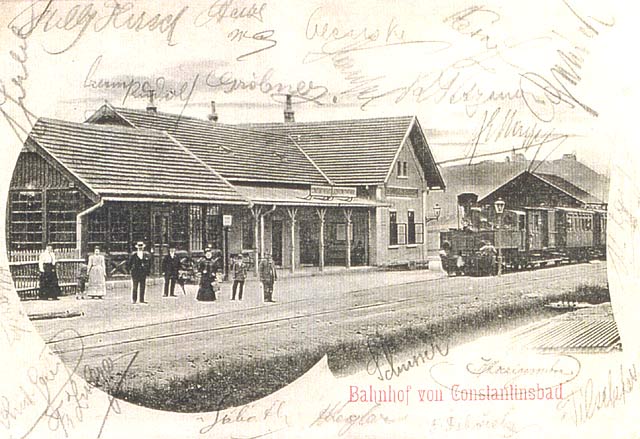
Former station Konstantinovy Lázně (today Kokašice) in the year 1902. In the background ruin of the castle Švamberk.
Collection Václav Simbartl
In 1918, the Czechoslovak Republic came into existence after the break-up of Austria-Hungary, and the operation on the private local railway was taken over by the Czechoslovak State Railways (ČSD). The use of railcars since 1930 brought about running time reduction from the original 90 minutes to one half, and new stops were added – Břetislav and Lomnička. Also, the number of connections increased to 6-7 pairs a day.
World War II had considerable social and cultural consequences for the region, as it belonged to the “Sudeten” which had been populated mostly by ethnic Germans for 300 years. After the Munich Dictate of 1938, Czech inhabitants were expelled from the region in several days; after the War ended, the local German majority was displaced in return in 1946. The communist dictatorship after 1948 caused considerable cultural decline, which was manifested by the devastation of historical monuments. However, the local railway dutifully served to the growing transport, both passenger and freight. After the War, reliable M 131.1 railcars were used on the line, replaced with more modern M 152.0 type (today’s 810 series) after 1983. Steam engines in freight transport were replaced with the diesel ones in 1969.
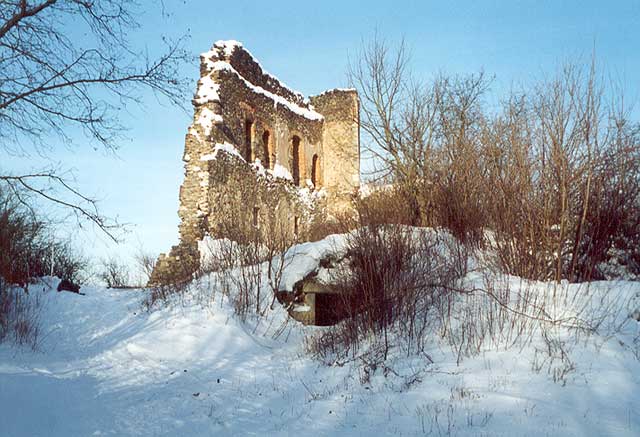
Ruin of the castle Švamberk in winter.
Photo M. Klas
The communist dictatorship was superseded by democracy in 1989. The related economic changes had great consequences for railways: the transport both of freight and of passengers by the local railway dropped. Discontinuance of operation on the line to Bezdružice was considered several times. It would have had negative impact on the transport services in a region where the roads are often passable only with difficulties in winter. The local railway is now an important part of the genius loci of the region without which successful tourism is inconceivable. Supporters of the preservation of the railway have been enhancing and promoting the line since 2001. Excursion train rides are organized, as well as voluntary work on the maintenance of the station and of some of the historical monuments along the line. In 2013, the reconstruction of the building of a former storehouse at Bezdružice was successfully completed where the local railway museum has been located since. A unique event, the Bezdružice Steam Summer (Bezdružické parní léto), a common attractive programme consisting in historical rides of railways carriages and road vehicles, accompanied by a rich cultural programme and gastronomical experiences, is organized in cooperation with other associations.
The regular service on the line has changed as well. Since 2014, most local railway trains do not end at Pňovany but have been lengthened to Pilsen. The comfort of the transport for passengers has improved after the RegioNova railcar units created by radical conversion of the original railcars series 810 were put into use. The majority of stations and train stop buildings on the line were gradually done up. The track itself underwent partial modernization already in 1980ies.
However, the bad technical condition of the great bridge over the valley of the Mže river near Pňovany posed a big problem, and there was even the threat that the operation would be discontinued. The general overhaul of the bridge took place in 2017-2018 and attracted wide attention both of the public and of European experts due to the unique technology of steel span replacement. The new spans were slid onto the old ones, connected with them, and the whole was then turned 180 degrees using a special jig so that the new span got to the place. The old one was then removed and disposed of. The modernized bridge was given an additional, uniquely made footbridge which became a popular tourist attraction.
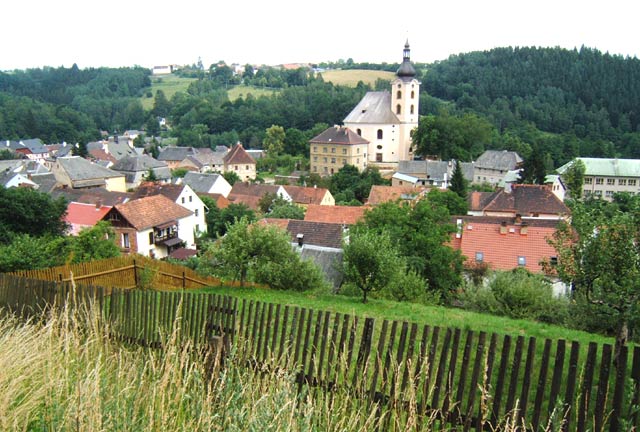
Small historical town Úterý.
Photo M. Klas
In 2022, 5-7 pairs of passenger trains run a day on the line Pňovany-Bezdružice, most of them Pilsen-Pňovany-Bezdružice. Freight trains run rarely, and almost exclusively to the stations of Cebiv and Trpísty.
The railway museum at Bezdružice is open for groups of visitors after previous order, or during historical train events. These are organized mostly on weekends – on Easter, at the beginning of October, and during summer months of July and August.
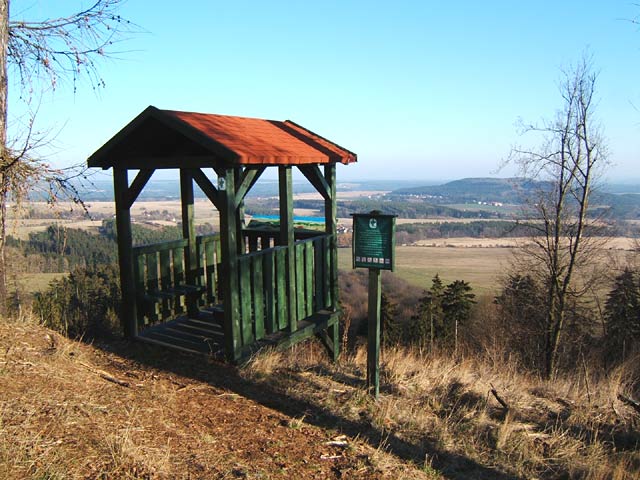
Ovčí hill above Konstantinovy Lázně.
Photo M. Klas
Accommodation and boarding in the region is possible mainly at Konstantinsbad. See accommodation possibilities here:
Recommendations for visitors:
- Romantic ruins of the Gutštejn castle
- Ruins of the Schwamberg caste on the Krasíkov hill
- Palaces at Bezdružice, Cebiv and Trpísty
- Railway museum at Bezdružice
- Úterý historical town
- Have a rest at Konstantinsbad and visit the Konstantin wellness centre
- Have a walk in the romantic valleys of the Úterský Potok or Hadovka brooks
- Haver a bathe at the municipal outdoor swimming pool at Konstantinsbad or at the Hradišťský Vrch lido in the former whinstone quarry
- Discover the vantage points on top of the Ovčí Vrch, Krasíkov and Hradišťský Vrch hills
- Discover the many natural mineral springs
- Visit the mini-zoo and the farm that sells local food at Krasíkov
- Have a bathe in the Hracholusky dam where seasonal water transport is in operation
- Have a walk across the high railway bridge over the Hracholusky dam
- Romanesque-style monastery of Teplá
- The town of Stříbro, heart of the region with a historical square and an original open-air mining museum
We will be happy to welcome you in our beautiful region under the castle of Švamberk, and we are convinced that you will pass an unforgettable time of rest here. Come to see us by the local railway that belongs to the most romantic ones in our country. That way you will do good not only to the railway and to the inhabitants of the region but also to yourself, as Konstantinsbad is the spa of your heart.
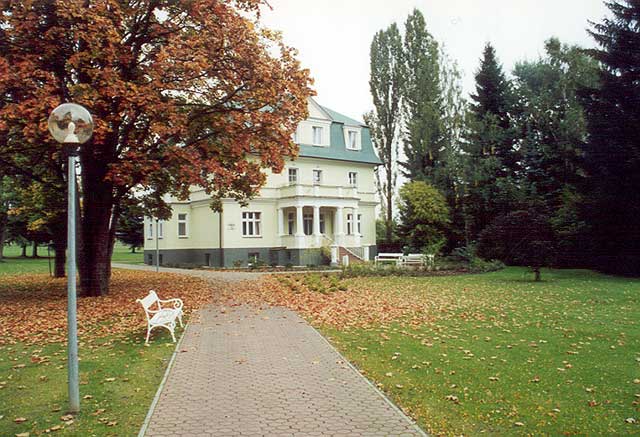
Konstantinovy Lázně spa in October.
Photo M. Klas
Contacts
- Contact to Pilsen - railway association (orderof historical trains journeys):
- Phone: + 420 604 827 735, Mr. Plochý
- E-mail: info@plzenskadraha.cz
- Website: www.plzenskadraha.cz
- Information service of microregion Konstantinolázeňsko:
- Website: ACCOMODATION
- Contact to author of local railway sites:
- E-mail: bezdruzice@spvd.cz
- Website: http://spvd.cz
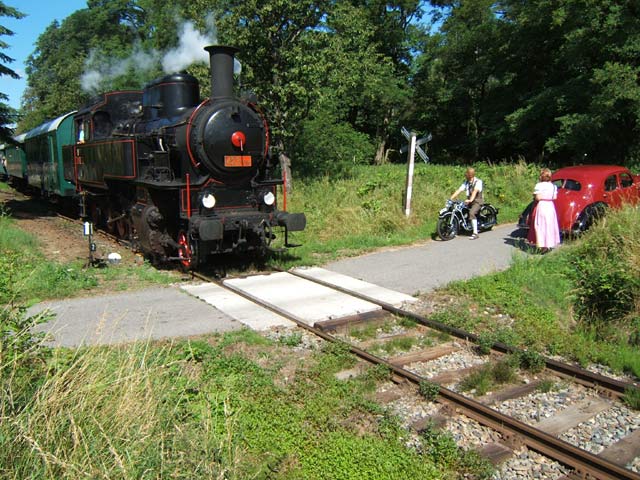
Steam train and a historical car near the station Konstantinovy Lázně.
Photo M. Klas (15. 7. 2006)
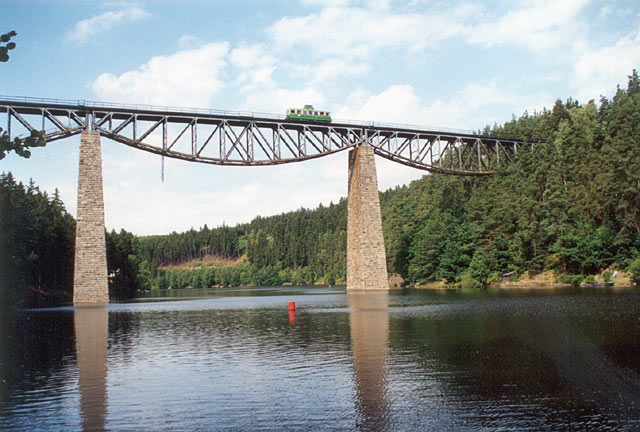
Bridge over the valley of the river Mže (today Hracholusky dam). Historical motor train called "Tower" on the bridge.
Photo M. Klas (15. 7. 2001)
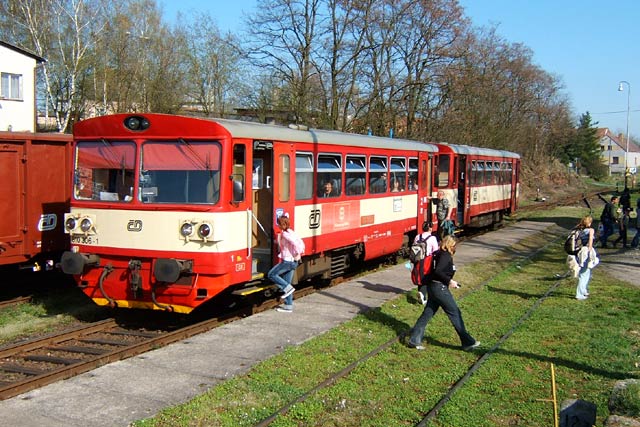
Motor train type 810.306 in the station Cebiv.
Photo M. Klas (13. 4. 2007)
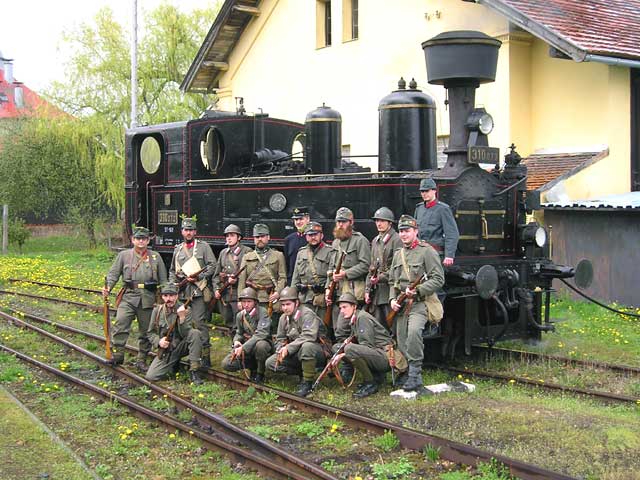
Steam engine set 97 (today 310.072) in the station Bezdružice with the historical group "Regiment No. 35" from the First World War.
Local railway Pňovany - Bezdružice
author: Miroslav Klas, translation: Lucie Cekotová, webmaster: Jiří Šplíchal
last modified: 15. 2. 2022
author: Miroslav Klas, translation: Lucie Cekotová, webmaster: Jiří Šplíchal
last modified: 15. 2. 2022

